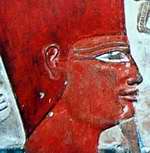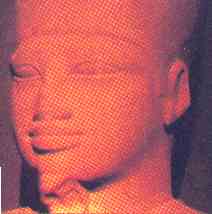

The Eleventh Dynasty
![]() The
Eleventh Dynasty was an interesting time in ancient Egyptian history. It marked
the beginning of the Middle Kingdom, and took up the task of restoring Egypt
from the chaos it had been in at the end of the Old Kingdom. It is one of the
most important times in all of ancient Egyptian history, because it is the transition
from the old corruptions that brought the Old Kingdom down, to the more stabilized
system established by the Middle Kingdom pharaohs.
The
Eleventh Dynasty was an interesting time in ancient Egyptian history. It marked
the beginning of the Middle Kingdom, and took up the task of restoring Egypt
from the chaos it had been in at the end of the Old Kingdom. It is one of the
most important times in all of ancient Egyptian history, because it is the transition
from the old corruptions that brought the Old Kingdom down, to the more stabilized
system established by the Middle Kingdom pharaohs.
To fully understand the importance of the Eleventh Dynasty, one must first look at what it is that saw the end of the Old Kingdom. The Old Kingdom was really the beginning and set-up for the next 3,000 years. During that time, pharaohs gained more and more strength as rulers, the pyramids were born, and a main, nature-based religion was established. Many advanced medical techniques were invented and practiced as a result of Imhotep, the world's original genius. All this was set-up during the Old Kingdom, and allowed for Egypt to see her course over the next few millennia. It is only at the end of the Old Kingdom that we see corruption. This was the result of religion being practiced as more of a form of gaining power, than anything else. There was also upheaval and forms of bad government going on then. The real killer, however, was the series of bad crops that were due to the Nile not flooding as consistantly as it should have. More can be found at this link.
 It
begins with Mentuhotep II (left) reuniting the two halves of Upper and
Lower Egypt in 2040 B.C. He was the one who brought the country to order after
what is known as the First Intermediate Period. (The First Intermediate Period
is the gap between the end of the Old and beginning of the Middle Kingdoms.
The two halves of the country had divided and fallen into disorder for the first
time since Menes first unified Egypt.)Although
his reign was, for the most part a peaceful one, there is evidence of a battle
during the later part. Buried near his morturary temple and tomb at Deir el-Bahari,
are 60 soldiers. "In the tomb of a local prince or general named Mesehti
at Asyut, we also find models of marching Egyptian soldiers and even in the
tombs of common people, we find an increase in the inclusion of weapons among
grave goods." (Taken from a longer article on Mentuhotep II that can
be found at http://www.touregypt.net/featurestories/mentuhotep2.htm).
It
begins with Mentuhotep II (left) reuniting the two halves of Upper and
Lower Egypt in 2040 B.C. He was the one who brought the country to order after
what is known as the First Intermediate Period. (The First Intermediate Period
is the gap between the end of the Old and beginning of the Middle Kingdoms.
The two halves of the country had divided and fallen into disorder for the first
time since Menes first unified Egypt.)Although
his reign was, for the most part a peaceful one, there is evidence of a battle
during the later part. Buried near his morturary temple and tomb at Deir el-Bahari,
are 60 soldiers. "In the tomb of a local prince or general named Mesehti
at Asyut, we also find models of marching Egyptian soldiers and even in the
tombs of common people, we find an increase in the inclusion of weapons among
grave goods." (Taken from a longer article on Mentuhotep II that can
be found at http://www.touregypt.net/featurestories/mentuhotep2.htm).
 His
son, Mentuhotep III (left), took the throne after his death. Mentuhotep
III continued with some of the same policies and campaigns as his father, but
is more well-known for beginning the quarry work at Wadi-el-Hammamat. He sent
workers there to gather building material for the many projects that went underway
during his relatively short reign. Because his father's reign was so long, Mentuhotep
III was already getting on in years by the time he took the throne. He reigned
but a minor 12 years, from about 2010 B.C. to 1998 B.C.
His
son, Mentuhotep III (left), took the throne after his death. Mentuhotep
III continued with some of the same policies and campaigns as his father, but
is more well-known for beginning the quarry work at Wadi-el-Hammamat. He sent
workers there to gather building material for the many projects that went underway
during his relatively short reign. Because his father's reign was so long, Mentuhotep
III was already getting on in years by the time he took the throne. He reigned
but a minor 12 years, from about 2010 B.C. to 1998 B.C.
![]() Then
we come to a very interesting part and end of the 11th Dynasty. The Turin King
List notes seven years which are missing between the end of the 11th and beginning
of the 12th Dynasties. This gap can be filled by a much lesser known pharaoh;
the mysterious Mentuhotep IV. (His cartouche can be seen above, at left).Not
much is known about him, and he is not even recorded in most King Lists. The
only real record that has been found of him are the few inscriptions left behind
at the quarries of Wadi el-Hammamat.
Then
we come to a very interesting part and end of the 11th Dynasty. The Turin King
List notes seven years which are missing between the end of the 11th and beginning
of the 12th Dynasties. This gap can be filled by a much lesser known pharaoh;
the mysterious Mentuhotep IV. (His cartouche can be seen above, at left).Not
much is known about him, and he is not even recorded in most King Lists. The
only real record that has been found of him are the few inscriptions left behind
at the quarries of Wadi el-Hammamat.
Despite the mystery surrounding him, he is one of the most important pharaohs. He saw the end of the 11th Dynasty, making it so that Egypt could move onto the 12th. In addition, Mentuhotep IV shows us that Egypt was now stabilized and ready for a new dynasty to begin.
